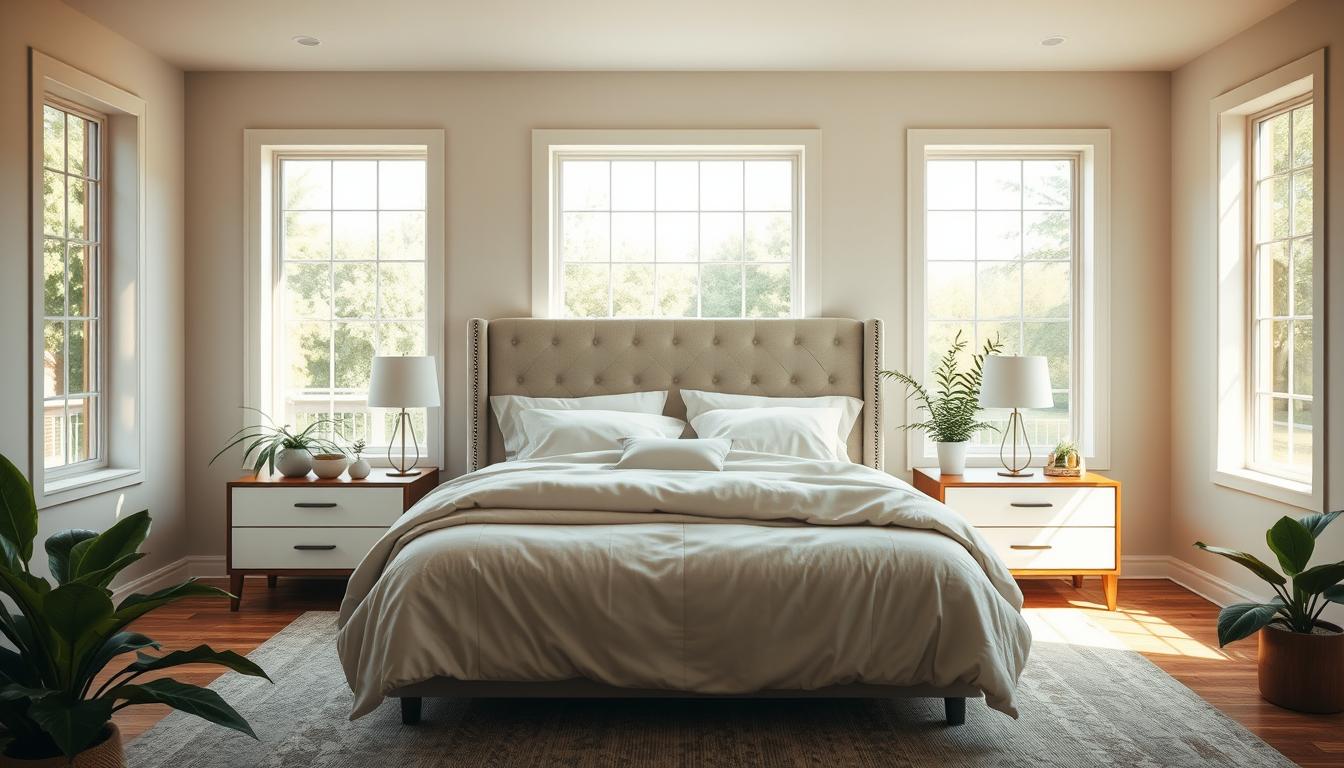Physical Address
304 North Cardinal St.
Dorchester Center, MA 02124
Physical Address
304 North Cardinal St.
Dorchester Center, MA 02124

Nearly one in three adults reports regular poor sleep, and that shortfall harms mood, thinking, heart health, and metabolism.
You can change that. Small, consistent shifts in light exposure, daily schedules, and bedroom setup move the needle fast.
This section gives a clear snapshot of why sleep matters and which evidence-backed habits make the biggest impact on your nightly rest.
Daytime bright light and a steady wake-sleep schedule support your circadian rhythm. In the evening, cut blue-screen time and watch caffeine and alcohol timing.
Optimize your bedroom: aim near 65°F, keep it dark and quiet, and use a calm wind-down routine. Short early naps and regular exercise help when timed right.
Poor sleep cuts into both your daily focus and long-term health. Even a few nights of short or irregular rest quickly show up as slower reactions, fuzzy thinking, and mood swings. Those immediate hits make driving, work, and parenting more dangerous and tiring.
Your brain relies on stable sleep for memory, judgment, and emotional balance. When sleep is fragmented, reaction time slows and anxiety rises, which then makes it harder to fall asleep the next night.
Poor sleep also strains the cardiovascular system. It can raise blood pressure and change glucose handling, boosting long-term risk for obesity and diabetes. These metabolic effects stack over years when short sleep becomes routine.
Daytime lapses cost you at work and on the road. Drowsy driving and workplace errors increase when your sleep quality is low. Your immune response weakens, too, so you may get sick more often.
Alcohol and nicotine worsen breathing problems like sleep apnea and snoring. That further cuts oxygen during sleep and multiplies health risks. Across many studies, regular sleep‑wake timing correlates with better perceived sleep and steadier energy across the day.
Bottom line: protect your sleep tonight to protect your overall health, performance, and long-term well‑being.
A clear daily light pattern helps your body know when it’s time for action and rest. Bright mornings anchor your circadian rhythm and help you fall asleep faster at night. Dim evenings let melatonin rise naturally so your brain can wind down.
Get outside or open blinds within an hour of waking. Aim for 20–30 minutes most days to set your internal clock. This simple habit shortens sleep onset and boosts nightly sleep quality, especially in winter.
Reduce bright screens and lamps 1–2 hours before bed. Use night modes, dimmer bulbs, or blue‑blocking glasses to protect melatonin production.
| When | Action | Benefit |
|---|---|---|
| Morning (within 1 hr) | 20–30 min sunlight or light box | Stronger circadian rhythm; easier sleep onset |
| Afternoon | Keep spaces bright for alertness | Better daytime focus; anchors clock |
| Evening (1–2 hrs before bed) | Dim lights; limit screens | Melatonin supports sleep quality |
Create a clear sequence of actions each night so sleep becomes automatic. Use the 10-3-2-1-0 rule as a simple framework and adapt it to your life.
10: stop caffeine about ten hours before bedtime to prevent stimulant effects.
3: finish alcohol and large meals three hours before you lie down so digestion won’t disrupt rest.
2: wrap up work and taxing tasks two hours before sleep to lower alertness.
1: turn off screens one hour before bed to protect melatonin and reduce blue light.
0: no snooze—the single best step to reinforce your wake time and strengthen sleep drive.
Expect small wins in a few nights and clearer improvement across two to four weeks. Consistency across times and days magnifies results.
Use a simple sleep diary to log bed and wake times, which steps you followed, and how you felt the next day. That record helps you refine habits and see what truly helps you improve sleep.
| Step | Action | Why it helps |
|---|---|---|
| 10 hours | Stop caffeine | Reduces late stimulant effects for easier sleep onset |
| 3 hours | Limit alcohol & heavy meals | Prevents reflux and fragmented sleep |
| 2 hours | Finish intense work | Allows mental winding down and lower arousal |
| 1 hour | Screens off | Protects melatonin and lowers brain stimulation |
| 0 snooze | Wake without snoozing | Builds stronger sleep pressure and steady wake time |
How and when you sip caffeine has a direct effect on how long and how well you rest at night. Late caffeine can cut about 45 minutes from total sleep and lower sleep efficiency by ~7%.
Aim to stop caffeinated drinks at least 8 hours before your target bedtime. For high-dose supplements, allow up to 13 hours so your body clears stimulants and REM sleep rebounds.
If cravings hit in the evening, swap to decaf, herbal tea, or a brisk 10-minute walk. Slowly shift your last cup earlier by 30–60 minutes every few days until it matches your goal.
“Small timing changes can restore nearly an hour of sleep and improve how refreshed you feel the next day.”
Track your response: note your usual last cup, move it earlier, and record changes in sleep duration and quality. Personal sensitivity varies, so adjust the cutoff time until your sleep improves.
Use naps as a tool: brief, early, and planned so they help rather than hurt your nightly sleep.
Keep most naps to about 20 minutes. Short rests boost alertness without driving you into deep stages that cause grogginess. These quick breaks often restore focus and mental clarity.
Aim for an early afternoon slot that matches your normal energy dip. That timing complements your circadian rhythm and is less likely to push bedtime later.
Skip naps when you are rebuilding sleep drive after a poor night. Forgoing daytime rest can help you fall asleep more easily and protect long-term sleep quality.
Track how naps affect your night: note the time you nap and whether your night sleep changes. Adjust length and frequency until naps support rather than disrupt your routine.
Pick a fixed wake-up moment and let the rest of your night fall into place around it. A steady time to rise gives your body a clear signal and makes nightly sleep more predictable.
Choose a non-negotiable wake time and work backward so you protect at least seven hours in bed. Add a 30–60 minute wind-down buffer before your planned bedtime.
Adjust gradually: move your schedule 15–30 minutes earlier every few days until you hit your goal. Keep your wake moment steady across the week, including weekends, to train your internal clock.
Use brief, simple cues before lights out—dim lights, calm activity, and no screens—to make the buffer effective. If you slip, avoid oversleeping; a short early-afternoon nap can help you stay on track without resetting the night.

After several weeks of consistency, many people begin waking near their set time without an alarm. That natural rise is a clear sign your body has adapted and your nights contain deeper, more reliable sleep.
A quiet, cool, and dark space sends a clear signal that it’s time for rest. Start by tuning simple elements of your bedroom so each cue supports better sleep at night. These changes focus on temperature, light, noise, and air quality—beyond just the bed.
Set your thermostat near 65°F (18–20°C) and pick breathable sheets. If you run warm, use lighter blankets or a fan so you stay comfortably cool through the night.
Use blackout curtains or a sleep mask and dim device displays before bed. Move chargers and bright screens outside the bedroom to avoid alerts that interrupt melatonin release.
Match solutions to your sensitivity: fans, white-noise machines, earplugs, or low-volume sound masking can cut disruptive noise and steady background sounds for better rest.
Ventilate when possible, replace HVAC filters, and reduce dust and pet dander so breathing stays easy overnight. A clean environment supports deeper, more restorative sleep.
| Factor | Target | Why it helps |
|---|---|---|
| Temperature | 65–68°F | Promotes sleep onset and stays comfortable |
| Light | Blackout curtains / mask | Supports melatonin and fewer awakenings |
| Noise | White noise or earplugs | Reduces sudden disruptions and improves continuity |
| Air | Ventilation & clean filters | Easier breathing and less allergy-triggered wake-ups |
Your bed setup has an outsized effect on how rested you feel each morning. A medium-firm mattress often balances support and comfort and can reduce back pain for many people.
Try a mattress that keeps your spine neutral. You’ll assess whether a medium-firm mattress aligns your hips and shoulders to cut aches that wake you at night.
Replace worn mattresses and pillows when you notice sagging, lumps, or persistent discomfort. Old bedding undermines support and hygiene.
Match materials to room climate and your body heat. Wool helps in cool rooms; linen works well for warmer nights; goose down may boost slow-wave sleep in cool conditions for some young adults.
What you eat in the hours before bed affects digestion, blood sugar, and sleep continuity. Aim to finish dinner a few hours before you lie down so your body can digest without interrupting rest.

Choose earlier, lighter dinners. Large or spicy meals close to lights out often cause reflux and fragmented sleep.
If you need a late bite, pick a small, balanced snack with protein and low simple carbs. That helps steady blood sugar and may reduce awakenings.
Limit fluids 1–2 hours before bedtime and use the bathroom right before lights out. This simple step cuts nocturia and keeps a deeper night.
| Action | Timing | Why it helps |
|---|---|---|
| Finish dinner | 2–3 hours before bed | Reduces reflux and sleep fragmentation |
| Bedtime snack | Small, low-carb option if needed | Prevents blood sugar swings that wake you |
| Limit fluids | Stop 1–2 hours before bed | Fewer bathroom trips and longer sleep blocks |
Tip: track which foods calm you versus those that keep you alert. These small changes will help you improve sleep tonight and moving forward.
Late alcohol and evening nicotine often trade easy sleep onset for fragmented night sleep. Alcohol may help you feel drowsy at first, yet it reduces restorative stages and disrupts your sleep quality.
Nicotine is a stimulant. Using it near bedtime makes it harder to fall and stay asleep. Smoke exposure also links with more fragmented rest and daytime tiredness.
Both substances can worsen snoring and increase the chance of sleep apnea. That raises overnight arousals and cuts deep sleep time.
Choose alternatives that help you wind down: herbal tea, a warm shower, soft reading, or gentle breathing. If you want to cut nicotine, seek professional support and stepwise plans.
Track changes: note when you stop these habits before bed and watch how your morning alertness and overall sleep change. Most people see clearer, more continuous rest within days to weeks.
A short, predictable wind-down signals your body that sleep is coming. Build a 30–60 minute routine that lowers arousal and quiets the mind.
Start with simple breathwork. Try 4-4-6 slow breaths for five minutes. Controlled breathing calms your nervous system and eases tension.
Use brief guided meditation or progressive muscle relaxation to release tight muscles. Work from toes to head, tensing then letting go.
These evidence-based practices reduce pre-sleep worry and help you fall asleep more often. Track which method shortens your sleep latency and repeat it.
About an hour before bedtime, put screens away. Blue light and mental engagement delay melatonin and keep your brain alert.
Choose quiet reading, light stretching, guided imagery, or a warm bath. A warm shower followed by cooling helps your core temp drop, a natural cue for falling asleep.
Keep the routine simple and repeatable so your mind links these steps with rest. Try small changes and note which ways help you fall asleep faster.
| Technique | Duration | When to use | Why it helps |
|---|---|---|---|
| Breathwork (4-4-6) | 5–10 min | Start of wind-down | Reduces heart rate and mental arousal |
| Progressive muscle relaxation | 10–15 min | Mid routine | Releases body tension for smoother sleep onset |
| Quiet reading or stretching | 15–30 min | Final buffer before bed | Low stimulation; avoids blue light |
| Warm bath or shower | 10–20 min | 30–60 min before bed | Aids gentle core temperature drop that supports falling asleep |
Regular movement during your day helps your nights fall into place.
Daily activity supports sleep quality and can reduce insomnia symptoms. Aim for about 150 minutes of moderate activity each week, spread across most days, to build consistent sleep drive.
Choose a mix of walking, yoga, and strength work. These types of sessions raise fitness and help your body recover overnight.
Note how timing affects your sleep and move strenuous sessions earlier if you notice harder time falling asleep. With steady habits, you’ll likely improve sleep and feel more refreshed each morning.
Using supplements wisely can gently support sleep when core habits are solid.
Melatonin can help with timing sleep onset. Typical doses range from 0.1–10 mg and are often taken up to two hours before bed. Start with a low amount and watch your response over several nights.
Take melatonin within two hours of your target bedtime. Lower doses often work as well and reduce next‑day grogginess.
Make sure you consult a clinician if you take other medicines, are pregnant, or have chronic conditions. Children need medical guidance before use.
Options with some supporting evidence include magnesium, omega-3s, zinc, resveratrol, glycine, valerian, chamomile, and dietary nitrate.
Supplements are not tightly regulated. Choose third‑party tested brands, try one product at a time, and record benefits and side effects in a sleep diary.
“Supplements support habits; they do not replace good sleep hygiene.”
If sleep feels fragile despite good habits, medical causes may be at play and deserve attention.
Warning signs include loud snoring, witnessed breathing pauses, choking awakenings, restless legs, or persistent insomnia that lasts weeks. Noticeable daytime sleepiness or trouble concentrating are also red flags.
About 33.9% of men and 17.4% of women in the U.S. show signs of sleep apnea. At least 10% of adults have chronic insomnia and another 20% get it sometimes.
Take action if you or bed partners report gasping, long pauses, or repeated awakenings. Restless legs and chronic trouble falling or staying asleep also merit evaluation.
Start by talking with your clinician. Home sleep tests can identify sleep apnea; some cases need in‑lab studies. If insomnia persists, cognitive behavioral therapy for insomnia (CBT-I) is first-line and effective.
“Effective treatments exist for many sleep disorders; you do not have to manage this alone.”
Small daily moves can increase the time you spend in restorative deep NREM sleep. Deep sleep supports tissue repair, immune health, and memory consolidation, so adding more of it helps how your body recovers overnight.

High stress shortens deep sleep and fragments the night. Use brief breathwork, five to ten minutes of mindfulness, or gentle yoga each evening to cut hyperarousal.
Progressive muscle relaxation and guided breathing reduce racing thoughts and lower heart rate before bed. Try this most nights to defend slow-wave time.
“Lowering evening stress often shows up as deeper, longer NREM sleep within days.”
Anchor your clock with bright morning light, steady meal timing, and a fixed wake-up moment. A stronger circadian rhythm increases the odds of longer deep-sleep stretches.
Keep your bedroom cool, dark, and quiet. Moderate alcohol and skip late caffeine so slow-wave consolidation is not disrupted.
A focused plan that targets one or two habits can help you get a reliably good night.
Start today by fixing a wake time and getting morning sunlight. Those two moves help you sleep better quickly and shift your internal clock.
Add an evening screen curfew and a short wind-down. These simple ways and tips lower alertness and make falling asleep easier.
Set caffeine and fluid cutoffs, and tune your bedroom—cool, dark, and quiet—so you feel the benefit the next day. Small changes often yield a noticeably good night right away.
Plan earlier, lighter dinners and track progress with a sleep diary. If problems persist, seek clinical input so you can lock in more consistent, restorative good night sleep over time.